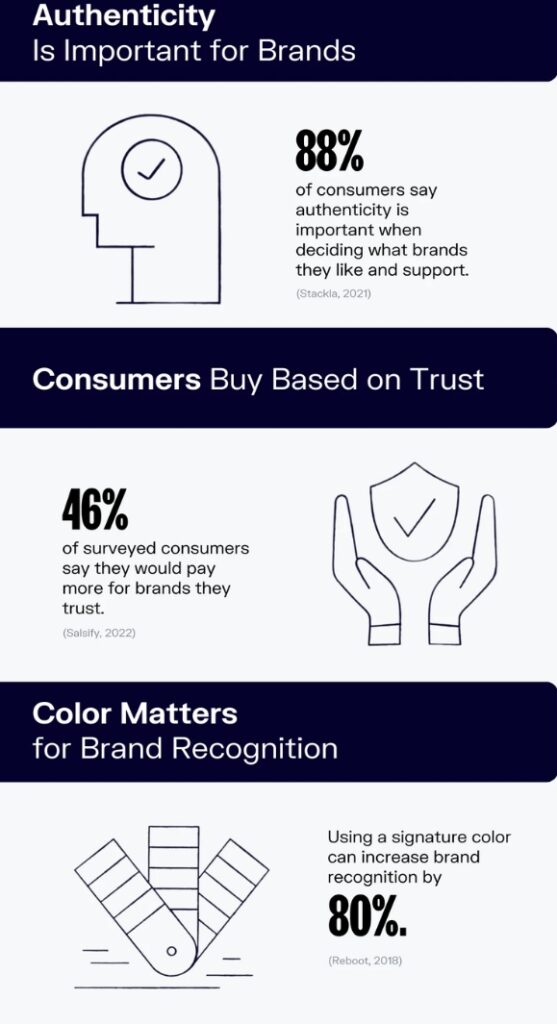Beyond the Brand: Creating an immersive and cohesive customer experience

Last week we hosted a workshop called Beyond the Brand, presented by Kevin Rose Jr., the founder of Unplugged Essentials. Unplugged products are sold at over 300 JC Penney stores nationwide and their Hemp Soaks were even named in “The Best 15 CBD Bath Products of 2021” by the NY Times Strategist.

As you can tell, Kevin has first hand experience creating a successful brand. In Beyond the Brand, he shared some of his most valuable insights on this process and why it matters.
His key points focused on the importance of creating an immersive customer experience by understanding your target audience, analyzing your competition and market position, maintaining brand consistency, and creating an emotional experience.
In this blog, I highlight these key points and provide you with some insights from the workshop. Starting with why it is important to establish a cohesive brand identity.

Credit: The information and visuals provided in this blog were curated and presented by Kevin Rose Jr. in Beyond the Brand on July 13, 2023
Why your brand matters

As consumers, our senses are flooded with branding and logos. Some of them capture our attention, but many of them go unnoticed. What makes the difference? What do consumers actually care about?
Creating a successful brand goes beyond the superficial look of your company or its catchy tagline. Your brand should encompass the entire customer experience, as it plays a vital role in shaping how people engage with your company, how much they trust it, and ultimately how much they are willing to pay for its products or services.
According to some interesting statistics Kevin shared, authenticity, trust, and consistency are key factors consumers consider when deciding what companies to support.
In order to establish these qualities, it’s important to know who exactly you are trying to reach.
Understanding Your Target Audience
A successful brand starts with understanding the consumers you want to reach and creating a clear picture of who they are. This involves identifying key characteristics, demographics, and psychographics to help you understand their needs, preferences, and aspirations.
For example, Kevin noticed that consumers of Unplugged Essentials tend to be primarily health conscious, yoga-loving, Apple users. Some details about your consumers might seem irrelevant. But these details help you understand your audience, what they care about, and the types of companies, products, and services that engage them.
By understanding these details and gaining deep insights into your audience, you can tailor your brand messaging, products, and services to resonate with them on a personal level.
Don’t forget that authenticity is key. Consumers can tell when a brand truly resonates with them or if it’s just trying to sell them something. So approach branding with integrity and core values. Be honest about what you have to offer, who it is best suited for, and what other options are out there.
Analyzing Your Competition and Market Positioning
To stand out in a crowded marketplace, it’s essential to analyze your competition and gain a comprehensive understanding of your market positioning. This is essential research for establishing a brand that reaches its target audience.
By studying your competitors’ offerings, strategies, and successes, you can identify holes within your niche that lead to opportunities to deliver more value to your customers. Paying attention to your market positioning will help you develop effective strategies that highlight your brand’s unique appeal.
The takeaway here is that when it comes to market competition, ignorance is not bliss. Learn everything you can about how your business stacks up against its competitors and use that information to carve out your brand’s niche, differentiate yourself, and create a competitive advantage that attracts and retains customers.
Now that you have a clear vision of your ideal customer, competitors, and market positioning, you can apply this information to create a consistent, cohesive, and immersive brand experience for your customers.
Maintaining Visual and Tonal Consistency

Consistency is key when it comes to building a strong brand identity. It builds trust, familiarity, and loyalty, which ultimately leads to increased brand recognition and customer engagement.
According to Reboot, using a signature color increases brand recognition by 80%
But your brand and logo goes beyond color.
A comprehensive set of guidelines will help you maintain visual and tonal consistency within your brand and across all brand communications. These guidelines cover key elements such as colors, typography, logo usage, and tone of voice.
There are great resources available to help you establish this consistency. The following are some that Kevin shared in his workshop:
- Coolors.co for color palette selection
- Typ.io for typeface
- Chatgpt for brand voice, tone and customer persona
It’s important to remember that your brand identity can change and evolve. Kevin recommends doing regular personal audits of your brand in order to build on what works and pivot away from what doesn’t.
For example, Kevin noticed that his audience cares about sustainability, so he changed his products and packaging, in part, to reflect this value.
Think of your brand as a conversation between your business and its audience. What is your brand saying to them, and how are they responding? Don’t ignore them. Listen and respond in turn. Your brand should meet the needs, values, and preferences of its ideal customer. This is what going beyond the brand is all about.
Creating Emotional Connections and Memorable Brand Identity

Design principles are important when creating a memorable and impactful brand identity that resonates with your target audience. You want to create a sensory experience that reflects your brand values and evokes specific and desired feelings within your customers.

Consider the photos shown here that were taken from the Unplugged Instagram page. Perhaps these photos remind you to slow down and practice self-care. Maybe they even evoke the scent of a warm bath and essential oils.
A well-designed brand triggers positive associations and enhances the overall customer experience. It becomes a powerful tool for establishing strong brand recognition, differentiation from competitors, and recall.
By strategically employing design elements, whether it’s shapes, colors, or imagery, you can create emotional connections and evoke desired feelings in your customers.
Final Takeaway
Going beyond the brand means thinking deeply and intentionally about the experience you want to create for your customers, and doing so with integrity. Implementing the above design principles and cultivating emotional connections can establish a cohesive and immersive experience that is memorable and impactful. Understanding your target audience, analyzing your competition, and maintaining visual and tonal consistency are fundamental steps in this process.
Remember to encompass the core values of your business and your customers when building your brand. Implementing these strategies can set your business apart and create a lasting connection with the people you want to reach.
Want to dive deeper into more marketing topics? Join us at Marketing Lab every Wednesday at 11am in New Bedford, MA or via Zoom. Open to all Groundwork members!
Not a member but still want to attend events and workshops? You can try our social club membership.
- How to be a good member at a coworking space - September 19, 2024
- Silent Book Club & the value of reading alone, together - April 30, 2024
- Groundwork Gallery CALL FOR ART! Everything you need to know about how to submit - April 3, 2024
